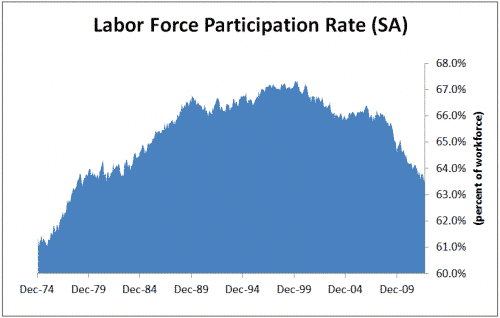The falling US labor force participation rate is not just a demographic issue
This is a quick piece here on the labor participation rate, following up on the piece I wrote last week about the jobs numbers not being consistent with recession. Mike Shedlock at Mish’s Global Economic Trend Analysis and Bill McBride at Calculated Risk have put up posts with opposing views on the now marked decline in US labor force participation.
The question is why is this labor force participation rate falling so steeply. Mish looks at some predictions for the rates fall as the US population ages and he finds a much more accelerated fall than was predicted. In his view this supports the view that much of the fall is recession- or economy-driven. Bill McBride looks at the 35-44 year-old cohort and finds no statistical anomalies in the falloff in labor participation and concludes that the fall has been due to secular demographic issues as the US population ages. I think this is a critical debate in determining the extent of any effects of the so-called balance sheet recession that many believe the United States is in.
My view comes from this key missing link via the Wall Street Journal:
“In September, the number of those 65 and over who were employed was up 21% from the same month in 2008, while broad workforce employment was down almost 1.4%. The size of the retirement-age labor force has also increased 23% during the past four years, while the broader labor force is up less than 0.4%. The group’s average labor participation rate this year is on track to increase 0.55 percentage point compared with 2011 and 1.35 percentage points from 2010 (unadjusted), while the broader participation rate is heading for 0.40 percentage point and one percentage point drops compared with those respective periods.”
How could we have a secular decline that is largely attributable to older people leaving the workforce when hordes of older people are staying in the workforce? It makes no sense whatsoever. Perhaps the argument is that it should be anticipated that these older people would work more and that their participation rate would increase but that overall participation would still decline because the US population is aging so rapidly. This doesn’t sound credible in the least.
Moreover, the Wall Street Journal says many people are working any way they can. They cite the huge uptick in part-time work as one form of this:
“the household survey also shows 582,000 of those new jobs were involuntary part-time positions. Workers told the Labor Department they took part-time work (usually 35 hours of less) because of slack business conditions or because it was the only job offered. Part-time jobs now account for 6% of all jobs, double their share before the Great Recession.”
Again, the question has to be how so many people desperate for jobs are taking on part-time work when they don’t want to and we have a secular decline in labor participation due mostly to secular forces that were long predicted. This makes no sense.
The data are consistent with economic distress, in terms of the record number of unemployed young adults, in terms of the huge uptick in senior employment and in terms of the huge uptick in part-time laborers. The totality of this is not consistent with a secular story rooted in the demographics of an aging population. Yes, workers are leaving the workforce because the US is aging. But, the data seem to demonstrate that there are fewer leavers than anticipated and that the larger decline in labor participation is a result of the balance sheet recession.
Watch for more discussion on this argument because it is key to understanding whether the recessionary and deflationary forces associated with this private sector debt downturn are long-lasting enough to constitute a Japanese-style balance sheet recession

Comments are closed.